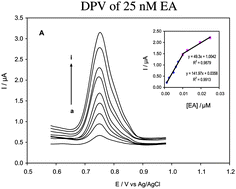Simultaneous determination of ellagic and gallic acid in Punica granatum, Myrtus communis and Itriphal formulation by an electrochemical sensor based on a carbon paste electrode modified with multi-walled carbon nanotubes
Abstract
An

* Corresponding authors
a
Department of Analytical Chemistry, Faculty of Chemistry, University of Kashan, Kashan, I.R. Iran
E-mail:
s.m.ghoreishi@kashanu.ac.ir
Fax: +983615552930
Tel: +983615912375
An

 Please wait while we load your content...
Something went wrong. Try again?
Please wait while we load your content...
Something went wrong. Try again?
S. M. Ghoreishi, M. Behpour, M. Khayatkashani and M. H. Motaghedifard, Anal. Methods, 2011, 3, 636 DOI: 10.1039/C0AY00691B
To request permission to reproduce material from this article, please go to the Copyright Clearance Center request page.
If you are an author contributing to an RSC publication, you do not need to request permission provided correct acknowledgement is given.
If you are the author of this article, you do not need to request permission to reproduce figures and diagrams provided correct acknowledgement is given. If you want to reproduce the whole article in a third-party publication (excluding your thesis/dissertation for which permission is not required) please go to the Copyright Clearance Center request page.
Read more about how to correctly acknowledge RSC content.
 Fetching data from CrossRef.
Fetching data from CrossRef.
This may take some time to load.
Loading related content
